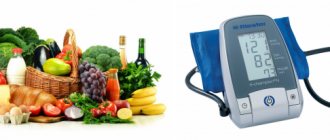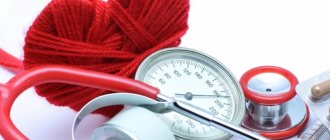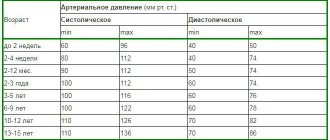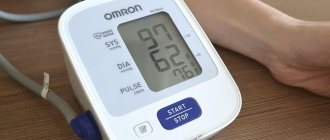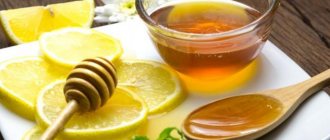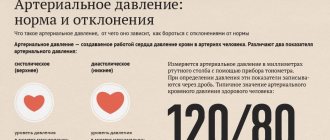Processes associated with an increase in blood pressure are symptoms of a specific disease or an independent disorder of vascular tone regulation.
In the latter situation, the disorder is called hypertension and has its own code according to the ICD, that is, it is recognized as a separate deviation.
To correct this condition, you need to change your lifestyle, give up bad habits and, of course, adjust your diet.
Basic metabolic processes, as well as water-salt metabolism, and, ultimately, blood pressure indicators largely depend on the quality and nature of nutrition.
If we talk about menu selection, the issue is decided at the discretion of the patient himself. It is better to exclude some foods altogether, while others, on the contrary, should be included in the diet.
A good solution would be to consult with a specialized specialist, a nutritionist. He will help develop nutritional principles. Or, in extreme cases, a doctor who conducts his activities on issues with the patient’s hormonal background - an endocrinologist.
Otherwise, it is recommended to adhere to the list below.
Citrus
The most preferred are lemons, oranges, and grapefruits. The beneficial therapeutic effect is based on the ability to influence the state of the cardiovascular system:
- Large amounts of ascorbic acid or vitamin C help protect arteries and capillaries from destruction. Increases elasticity, helps to better tolerate any load. This is especially important for patients suffering from hypertension.
- Flavonoids help thin the blood. In addition, these specific compounds affect metabolic processes in the body. This means that all citrus fruits can be used to prevent atherosclerosis. Of course, in moderation.
Products that lower blood pressure, such as oranges, tangerines, and grapefruits, can be used in their pure form or juiced from them.
Lemon contains a lot of acid, making it much more difficult to consume. If desired, you can add a slice to lukewarm tea. Not hot. Vitamin C does not tolerate overheating and is destroyed.
Microelements that help reduce blood pressure
To correctly create a menu, it is not enough to know products for lowering blood pressure. It is necessary to understand what beneficial substances they contain and help the normal functioning of the body.
Folic acid
Folic acid (vitamin B) is an antioxidant; in the human body it is responsible for the removal of toxins and affects hematopoietic processes. Folic acid is prescribed to women at the beginning of pregnancy; moreover, this substance helps lower blood pressure. Replenish vitamin B deficiency with:
- legumes - beans or peas,
- citrus fruits - grapefruits, limes, oranges, lemons,
- nightshades - sweet peppers and tomatoes.
Please note that greens are high in folic acid. In summer, hypertensive patients are recommended to eat onion, celery, and parsley. In winter, spinach will help replenish folic acid deficiency.
Ascorbic acid
Vitamin C (or ascorbic acid) regulates cholesterol levels, participates in the breakdown of fats, and prevents blood clots. Ascorbic acid is present:
- in rosehip decoctions,
- berries of wild and garden crops - currants of any variety, raspberries, cherries, chokeberries, cranberries, lingonberries,
- in garlic
- fresh apples,
- citrus fruits.
Minerals
Any foods containing potassium, magnesium or phosphorus lower blood pressure. Magnesium is responsible for reducing the tone of the walls of blood vessels, phosphorus strengthens them and is responsible for the breakdown of fats. Potassium is involved in the removal of sodium salts from the body. You can get your daily requirement of these minerals by consuming:
- seafood - fish, granular caviar, seaweed,
- nuts – pine, peanut, almond, walnut,
- sunflower seeds,
- dried fruits - raisins and dried apricots.
Please note that sea fish should be consumed baked, boiled or stewed, as well as as part of first courses. Salted, dried and smoked fish are excluded from the menu for hypertensive patients.
Vegetables
Several names can be included here.
- Beet. Like the previous group, it contains a lot of ascorbic acid, which acts as an antioxidant. Prevents changes in the vascular wall and its destruction and degeneration.
In addition, this healthy vegetable contains potassium. An important element for maintaining electrolytic balance and regulating vascular tone.
There is no need to abuse it, since the vegetable has a pronounced laxative effect and provokes intestinal disorders if used excessively.
- Garlic. Contains allicin, an important ester compound. It is this that gives the vegetable its sharp taste and creates a burning sensation. Promotes reflex relaxation of the walls of blood vessels (thereby lowering pressure), then, when absorbed, helps consolidate the result.
In addition, the product has a diuretic effect, although not strong. Eliminates excess water from the body. At the same time, with excess consumption it provokes the opposite effect. 1-2 cloves per day is enough.
- This also includes spinach. It contains many vitamins, as well as magnesium and potassium. Important electrolytes that help equalize blood pressure and restore vascular elasticity.
Clinical picture
Hypertension is a pathology of the cardiovascular system, characterized by a persistent increase in blood pressure. Today, every third person on the planet suffers from the disease (mostly people in the older age group).
Content:
- Clinical picture
- Basic principles of nutrition
- Products that lower blood pressure
- Sample menu
- Bee products against hypertension
- Conclusion
The unit of measurement for blood pressure is considered to be millimeters of mercury. The value of arterial indicators is expressed by two numbers: the larger (systolic) and the smaller (diastolic). Moreover, the first value is recorded during maximum contraction of the heart muscle, and the second - at the moment of complete relaxation of the myocardium.
Normally, systolic pressure varies between 100 - 125 millimeters of mercury, diastolic in the range of 70 - 85. If these indicators exceed 140 (upper) and 90 (lower) units, arterial hypertension occurs.
In the pharmaceutical industry, it is customary to distinguish between 3 degrees of severity of pathology.
Mild (preclinical)
This stage of the disease is characterized by frequent abrupt pressure drops (short-term). At the same time, the systolic indicator varies in the range of 140 - 159 units, and the diastolic in the range of 90 - 99 units.
To correct preclinical hypertension, it is advisable to use folk remedies (since medications are not required).
Moderate (borderline)
The second degree of pathology is accompanied by an increase in upper pressure to 179 millimeters of mercury, and lower pressure to 109 units.
To reduce arterial values, pharmaceuticals (hypotonic drugs) are used. In the absence of proper therapy, a hypertensive crisis is possible, since the indicators remain at the borderline (upper) level for a long time.
Severe (chronic)
At the 3rd stage of the disease, systolic pressure exceeds 180 units, and diastolic pressure exceeds 110. Arterial parameters can only be stabilized with the help of medications.
If the disease is not stopped for a long time, irreversible changes develop in the “target organs” (kidneys, heart, brain, fundus vessels). At the same time, uncontrolled hypertension entails severe complications (strokes, encephalopathy, heart attacks, cognitive disorders, dementia, renal failure, etc.).
Symptoms characteristic of the first two stages of the pathology:
- dizziness;
- tinnitus (fullness);
- headache;
- fatigue;
- irritability;
- puffiness of the face;
- insomnia;
- “double vision”;
- swelling of the eyelids.
At the third stage of pathology, the following disorders occur:
- pain in the heart area;
- nausea;
- feeling of lack of air;
- tachycardia;
- redness of the skin;
- impaired coordination of movements;
- cognitive disorders (decreased memory, attention);
- blurred vision;
- "weakness" in the limbs.
Remember, timely diagnosis of the disease will help avoid serious complications: stroke, heart attack, heart failure.
Drinks that lower blood pressure
Tea. Just not black, as it has the opposite effect. Hibiscus (red) or green are best suited. Although the question regarding the latter remains quite controversial in medicine.
This drink is not recommended for patients with impaired renal function or insufficiency, since there will be an increase in blood pressure against the background of dysfunction and increased load.
Otherwise, this tea is very useful. It contains tannins, flavonoids, and other elements. Together, they give blood vessels their former elasticity, protect them from destruction, increase the speed of blood flow, and fight excess lipids, in particular cholesterol.
A combination of tea with ginger and lemon works well. You can add a small amount of honey to improve the taste. The main thing is that the drink is not hot.
High-quality cocoa gives approximately the same results. The powder contains a lot of magnesium; when using milk for preparation, the patient also consumes calcium.
In the system, these components help stabilize blood pressure levels. Although they do it gently. For patients with hypertension, the drink is allowed, but you should not count on a significant therapeutic effect.
For healthy people, cocoa can be recommended as a measure to prevent blood pressure surges.
The drink additionally has natural sedative and antidepressant effects. This means that the factor of possible increase in blood pressure – stress – is stopped.
High blood pressure in women - diet rules
Women tend to find it easier to adjust their diet and bad habits than men. Women drink alcohol less often and are less likely to suffer from nicotine addiction. However, more often than not, men have food addictions and tend to “eat up” stress with junk food. What diet rules for hypertensive patients should women follow:
- exclude fried foods,
- give up canned vegetables (fruits) and pickles, use fermented foods as a replacement,
- limit salt intake to 5 ml/day,
- exclude flour and sweets,
- If possible, replace meat dishes with fish,
- The last time to eat is no later than 3 hours before bedtime; in case of severe hunger, you can eat fruits, sugar-free juices, and fresh berries.
Spices and seasonings
Ginger has blood pressure-normalizing properties. Although formally it cannot be attributed to this group. This is a full-fledged independent product.
- The substances based on it thin the blood, acting as a natural antiplatelet agent.
- In addition, they help relax the vascular muscles, preventing further spasm and an increase in tonometer readings.
Turmeric is called a good help in prevention and even therapy. The substance of the same name in its composition helps to quickly reduce blood pressure, but gently, and therefore does not create health risks.
Hot cayenne pepper. He's chili. The product is used to rapidly reduce blood pressure. This is a reflex response to the use of capsaicin, which the product is so rich in.
But this can be dangerous, since a sharp jump in blood pressure does not affect the condition of the blood vessels (their elasticity). Pepper is allowed for hypertensive patients, but it should be eaten with caution.
Foods that reduce high blood pressure
If you need to lower blood pressure that has not risen critically, you should not immediately take antihypertensive medications. Many foods and drinks have the ability to reduce blood pressure readings to normal, and among them the most effective:
- rowan - red and chokeberry,
- cranberry,
- rose hip,
- beets and beet juice,
- potato,
- milk,
- fish (not salted),
- beef and pork liver,
- raw egg yolks,
- cottage cheese,
- cheese,
- butter,
- green vegetables,
- broccoli,
- tofu,
- almond,
- green tea and hibiscus,
- watermelons, melons,
- garlic,
- beans, beans,
- grain cereals,
- bran,
- walnuts,
- black currant,
- carrot,
- grapefruit,
- lemon,
- quince,
- celery,
- viburnum with sugar.
Fruits other than citrus
Pomegranate has special antihypertensive properties in this group. It is best to use its juice; drinking 50 grams of this healthy product per day is enough.
The fruit contains vitamin C and a lot of other active components. You can also find specific compounds that inhibit angiotensin, a component that affects the constriction of blood vessels and provokes their artificial spasm.
Potassium and magnesium complement the picture, acting as regulators of water-salt metabolism, and a slight diuretic effect is possible.
Recovery is achieved relatively slowly. After about six months to a year, it is possible to achieve a persistent drop in pressure levels by 7-15 units.
Because of these properties of pomegranate, it is prohibited for people with hypotension to consume it. Low blood pressure or a tendency to it. It may be dangerous. In small quantities and irregularly - at the discretion of the doctor and with his permission.
Another help can be called chokeberry. It should not be used for food purposes precisely because of its ability to sharply lower blood pressure readings.
At high blood pressure levels, this is a threat, since the risks of heart attack, stroke, and other emergency conditions rapidly increase.
Bananas help enrich the body with potassium. The fruit is suitable for lowering blood pressure, but is not recommended in large quantities for diabetics due to the starch.
How to quickly lower blood pressure
To achieve a quick reduction in blood pressure without medications at home, you can use one of the following methods.
- You can drink green tea with mint.
- Make a drink: dilute a tablespoon of honey in half a glass of mineral water and add the juice of half a lemon.
- Brew tea from three equal parts of hawthorn berries, motherwort herb and valerian root. It is a very effective sedative and antihypertensive agent.
- Drink a glass of low-fat kefir with half a teaspoon of cinnamon.
- Make the following mixture: mix a glass of freshly squeezed beet juice with a glass of honey, preferably May honey. You need to take it one tablespoon 3-4 times a day.
- You should also use deep breathing techniques: inhale and exhale with your stomach, slowly, trying to relax. You can make hot baths for your hands, contrasting ones for your feet, and apply a compress of apple cider vinegar to your feet.
- Mustard plasters on the calves and upper neck will help quickly reduce pressure.
Dairy products
Kefir and milk. You need to drink at least one glass of drink a day. Natural, with a minimum percentage of fat content (about 1.5-2).
It is not recommended to buy ultra-pasteurized types because they contain a lot of sugar. This is a ploy by manufacturers to get consumers to pay.
The effect of using fermented milk products is delayed. However, everyone can drink it, even patients with hypotension.
Although milk and kefir lower blood pressure, they do so gently and within small limits. Basically, they enrich the body with calcium if it is sufficiently digestible.
Drinks to increase blood pressure
Healing herbs and plants - ginseng, lemongrass, leuzea - tone blood vessels and fight hypotension. They are usually taken in the form of alcohol infusions, diluted in water. Drinks such as sweet soda, alcoholic drinks, coffee, tea, and cocoa are considered to increase blood pressure. Hot hibiscus tea increases blood pressure (as opposed to cold tea, which lowers it). An excellent way to increase blood pressure is pomegranate juice, grape juice (dark and tart), and red wine.
Fish
Marine. Even better - red. Although other varieties are suitable for the prevention and control of disorders.
One of the possible reasons for a stable increase in blood pressure is hypercholesterolemia.
That is, the actual increase in the concentration of lipids in the blood. As this condition develops, atherosclerotic plaques appear. Fatty deposits on the walls of arteries.
Fish contains polyunsaturated fatty acids, which naturally bind and remove harmful cholesterol.
With regular consumption of seafood-based dishes, you can achieve high-quality correction of the state of the cardiovascular system.
This also includes shrimp and other products. Not counting crab sticks and semi-finished products, saturated with salt in horse doses.
Prohibited foods for hypertension
If you want to stabilize your blood pressure, you will have to completely eliminate some foods from your diet. The following are contraindicated for hypertensive patients:
- Confectionery products are any high-calorie products containing large amounts of sugar.
- Animal fats - butter, fatty meat broths, smoked and dry-cured pork products, margarine.
- Consuming salt.
The best option for hypertensive patients would be a salt-free diet, excluding animal fats and replacing them with vegetable oils. It is recommended to exclude fried foods for baked and boiled ones. Try not to heat cooked food in a frying pan, but rather eat freshly prepared foods.
Nuts
Walnuts, hazelnuts, almonds. Contains arginine and citrulline. Both substances have the ability to remove cholesterol.
In the early stages, it is also possible to eliminate plaques based on it. In addition, they stabilize blood sugar levels.
To lower blood pressure, it is enough to eat 1-2 nuts per day. It is no longer worth it, including due to the high calorie content of the product.
General nutritional guidelines for people with hypertension
Often, adjusting your diet is enough to bring your blood pressure back to normal.
With proper nutrition, the condition in some patients stabilizes to such an extent that the doctor can reduce the dose of prescribed medications.
In the diet of a patient with this pathology, the consumption of the following products is reduced or eliminated:
- Salt should not be consumed more than 6-8 g per day. With an excess of sodium chloride, the removal of fluid from the body is delayed, which increases the volume of blood in the vessels. Most foods contain salt, so they don't need to be salted. If the taste seems bland, season the dish with lemon juice, herbs, and mild spices.
- Strongly brewed tea (green, black), coffee, cocoa, drinks containing alcohol cause vascular spasm, as a result of which the heart works more intensely. In addition, they stimulate the nervous system. The possibility of consuming these products is determined in each individual case.
- Animal fats cause the body to produce cholesterol, which clogs blood vessels and limits blood flow to the heart and other internal organs.
- Easily digestible, or fast carbohydrates (sugars) cause obesity.
Foods with potassium to strengthen the heart muscle
Increase the content of the following foods in your diet:
- Plant origin (vegetables, fruits, cereals), since they are rich in dietary fiber (fiber), prevent the absorption of harmful cholesterol and reduce its amount in the blood. Fiber also makes you feel full and prevents overeating.
- Products with magnesium and potassium - minerals that strengthen the heart muscle and increase its endurance.
- Products with vitamin C, which strengthens the walls of blood vessels. To preserve ascorbic acid content as much as possible, reduce the heat treatment time of the product or consume it raw.
Magnesium-rich foods to strengthen your heart muscle
Recommendations for older people
Hypertension is a disease that most often occurs in old age. And what’s interesting is that hypotension in youth often turns into hypertension with age. This means that you need to constantly monitor your blood pressure, especially if someone in the family suffers from this disease or you have its symptoms.
It is possible and necessary to maintain normal blood pressure not only with special medications, which your doctor will take care of. Proper and healthy nutrition is important, especially in old age, sufficient consumption of clean water, and moderate physical activity. You need to eat food 5-6 times a day in small portions, focusing on what your working pressure is. If you are hypertensive, create a diet based on the products from Part 1 of the article, and if you are hypotensive, sometimes include the foods and dishes listed in Part 2 in your menu, not forgetting to combine “harmful” with healthy ones.
Normalization of weight, positive emotions, intellectual pursuits, and communication based on interests have a very good effect on the well-being of older people. Create an atmosphere around yourself without stress and negative emotions, go to theaters, museums more often, visit exhibitions, just walk in nature - and your blood pressure will always be within normal limits!
Author: Tatyana Mylyan, nutritionist
